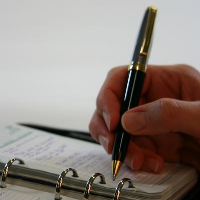
Dave Allen’s wildly popular, Getting Things Done system is great to stay organized. It achieves the goal of storing information, tasks and commitments so your brain doesn’t have to. Ever since I began working with the system the burden to my memory has gone down substantially.
The only problem is that GTD isn’t for everyone. Initially I found Dave’s system to be too large to meet my needs. I rarely used many of his suggestions for folders, calendars and planners. And when a system doesn’t get used, you stop checking it. When you stop checking it, you go back to using your memory and end up where you started.
My friend Leo over at ZenHabits offered another alternative which he called ZTD. I lean more towards using Leo’s system, but even that is insufficient. What you really need is some ideas to customize a system to fit your life, not Dave’s, Leo’s or mine.
Step One – Identify Information to Track
What kind of information do you need to keep track of regularly? To-do items? Project lists? Routine actions to perform? Commitments in the future? All of these? The first step is to identify what kind of information you need to track with your system.
Here’s just a few categories of information you might want to consider. I’d recommend starting with the essentials. Tracking too much information can pollute what’s important.
- Next actions in projects
- To-do items
- Routine actions to perform
- Future commitments
- Scheduled activities
- Goals and deadlines
- Information (books, reports, memos to be read later)
- Interests
Step Two – Create the Fewest Containers Possible
The key to an effective organizing system is to have as few containers as possible, that can still hold everything you need. A GTD-esque system requires you to check it regularly or it isn’t reliable. With less containers to check, you are more likely to check them frequently.
With your list of information sources to track, decide which of these containers you could use frequently:
- To-Do Lists
- Calendars
- Daily Goals
- Long-Range Goals
- Day Planner
- Various Folders/Binders
After a bit of introspection and experimentation I’ve found that to-do lists, a calendar, goals-binder and a few folders work best for me. Pick as few containers as possible that will still cover your information streams.
Step Three – Add a Notepad
There’s one container that needs to be added in any system, this is a notepad and pencil you carry with you everywhere. Even if your system covers 90% of your information streams immediately, having an input notepad will help you out if you are away from your computer or desk.
Step Four – Digital or Not?
With the explosion of new technologies to handle organizing and time-management, should you go digital or stick with paper and pen? I’ve used both and I can say each has its advantages. You’ll want to base your decision on a couple of factors:
- Access to Computers/Internet – If you’re like me and surrounded by technology all the time, digital might work better. But if you need to make frequent trips away from computers, paper and pen are probably best.
- Flexibility of Design – Some computer programs can give you more flexibility than their paper alternatives. I find Google Calendar’s easy functions that can store dates, times and locations far better than the wall-hanging variety. But I’ve also tried many goal-setting programs that are too complicated and lack the vividness of putting pencil to paper.
- Heavy Pockets – With web-based productivity apps, you can access your information anywhere you have internet. Paper solutions might mean more carrying on trips. Then again, paper solutions are still often lighter than a laptop if you need to haul all your digital equipment just to keep up.
Step Five – Tweak the System
Once you’ve got a basic system, the work is almost over. The next step is to fine-tune it. I don’t believe this fine tuning leads to any huge gains in productivity. But if you routinely find holes where your containers are leaking information, you need a tweak.
Here’s a question for you: What system do you use? Do you have a full GTD system or a slimmed down one like myself? Perhaps you have something even more exotic you’d like to share.


 I'm a Wall Street Journal bestselling author, podcast host, computer programmer and an avid reader. Since 2006, I've published weekly essays on this website to help people like you learn and think better. My work has been featured in The New York Times, BBC, TEDx, Pocket, Business Insider and more. I don't promise I have all the answers, just a place to start.
I'm a Wall Street Journal bestselling author, podcast host, computer programmer and an avid reader. Since 2006, I've published weekly essays on this website to help people like you learn and think better. My work has been featured in The New York Times, BBC, TEDx, Pocket, Business Insider and more. I don't promise I have all the answers, just a place to start.